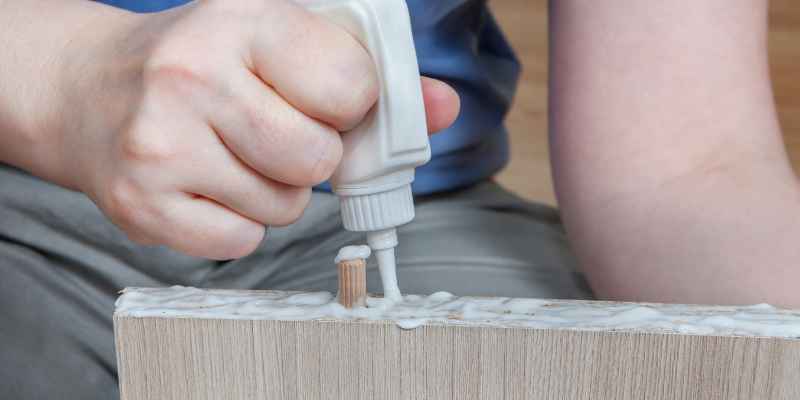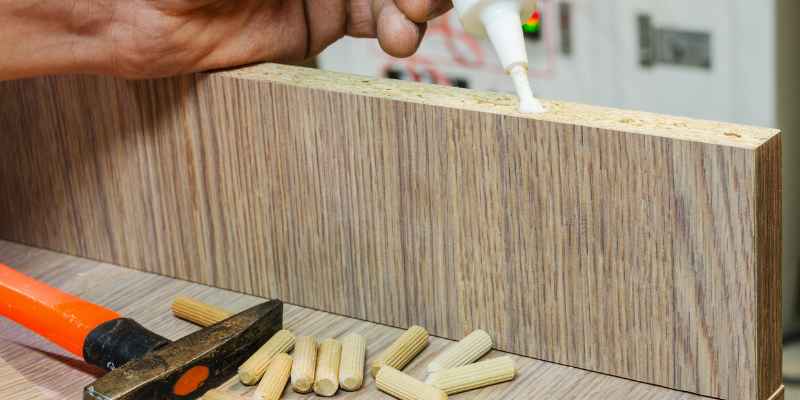Yes, Super Glue can effectively bond wood furniture together. Super Glue is a strong adhesive that can securely fix broken or loose pieces of wood, providing a quick and reliable solution for repairing wood furniture.
Whether it’s a chair leg or a drawer handle, Super Glue can create a durable bond that withstands everyday use and helps restore the functionality and aesthetic appeal of your wood furniture. This versatile adhesive is a popular choice for DIY enthusiasts and professionals alike due to its fast drying time and high bonding strength.
By using Super Glue on your wood furniture, you can easily fix minor damages without the need for costly repairs or replacements.
Understanding Super Glue
Super Glue is known for its strong adhesive properties, but when it comes to wood furniture, it may not always be the best option. While it can provide temporary fixes, using specialized wood adhesives is generally recommended for more durable and long-lasting repairs.
Super Glue is a widely-used adhesive known for its quick and strong bonding capabilities. If you’re wondering whether it works on wood furniture, you’ve come to the right place. In this section, we will delve into the composition and types of Super Glue to help you understand how it works.
Composition
Super Glue, also known as cyanoacrylate adhesive, is derived from a chemical compound called cyanoacrylate. This compound is created by the reaction between formaldehyde and cyanoacetate. When applied to a surface, it reacts with the moisture in the air, forming a strong bond within seconds.
The composition of Super Glue allows it to bond various materials, including wood furniture, quickly and effectively. However, it’s important to note that different types of Super Glue may have slightly different compositions, leading to variations in strength and performance.
Types Of Super Glue
There are several types of Super Glue available in the market, each designed for specific applications. Here are some common types you might come across:
1. Ethyl Cyanoacrylate: This is one of the most common types of Super Glue and is suitable for a wide range of materials, including wood furniture. It offers fast bonding and high strength.
2. Methyl Cyanoacrylate: Typically used for bonding metal and rubber, this type of Super Glue may not be as effective on wood furniture compared to ethyl cyanoacrylate. However, it can still be used for certain wood-related applications.
3. Gel Super Glue: This variant of Super Glue has a thicker consistency, making it ideal for vertical surfaces or situations where precise application is required. Gel Super Glue also provides a longer working time before it sets.
4. Wood-Specific Super Glue: Some Super Glues are specially formulated for wood surfaces. These types often contain additional ingredients, such as sawdust, to enhance the bond and create a seamless finish.
When using Super Glue on wood furniture, it’s essential to consider the type of glue that suits your specific needs and follow the manufacturer’s instructions for the best results. Remember to take into account the type of wood, the surface area to be bonded, and any other particular requirements.
Now that you have a better understanding of Super Glue and its different types, you can make an informed decision on whether it will work effectively to repair or stick wood furniture. However, always conduct a small test on an inconspicuous area before applying Super Glue on visible parts of your furniture to ensure compatibility and avoid any potential damage.

Using Super Glue On Wood Furniture
Super glue is a versatile adhesive that can be used for various purposes, including repairing wood furniture. Whether you have a loose chair leg or a broken tabletop, super glue can come to the rescue. However, using super glue on wood furniture requires proper preparation and application techniques to ensure a successful and long-lasting bond.
Preparation
Before applying super glue to your wood furniture, it is important to take the necessary preparation steps to ensure the adhesive adheres properly. Here are some important points to keep in mind:
- Ensure the surface is clean and free of any dust, dirt, or grease. Use a mild detergent and a soft cloth to gently clean the surfaces you will be gluing.
- If there are any old adhesive residues or finishes on the wood, remove them using a sandpaper or a scraper. This will provide a clean and smooth surface for the glue to bond to.
- Apply a small amount of glue to a test piece of wood to check for compatibility and any potential damage or discoloration that may occur. This will help you understand how the glue behaves with your specific wood furniture.
Application Techniques
When it comes to applying super glue on wood furniture, following the right techniques is essential to achieve a strong and reliable bond. Consider the following tips for a successful application:
- Apply the glue sparingly. Super glue is known for its strong bonding properties, so a little goes a long way. Using too much glue can result in messy, excess adhesive that can compromise the aesthetics of your furniture.
- Spread the glue evenly on the surfaces you are gluing together. A thin, even coat of glue will provide better adhesion and ensure a secure bond.
- Press the surfaces firmly together after applying the glue. Use clamps or heavy objects if needed to apply pressure for the recommended bonding time specified on the glue packaging.
- Avoid disturbing or moving the glued surfaces during the curing process. This will prevent any misalignment or weakening of the bond.
- Allow the adhesive to fully cure before using the furniture. This typically takes several hours, but it is important to check the specific instructions provided with the glue you are using.
Benefits Of Using Super Glue On Wood Furniture
Discover the benefits of using super glue on wood furniture: strong adhesive power for long-lasting repairs and quick fixes, saving you time and money. Experience sturdy and reliable results with this effective solution.
Strong Bonding
One of the standout benefits of using super glue on wood furniture is its ability to create a strong bond.
Super glue, also known as cyanoacrylate adhesive, is designed to create an incredibly strong bond that can withstand pressure and ensure the longevity of your wood furniture.
Whether you’re repairing a broken chair leg or attaching a loose drawer handle, super glue can create a reliable bond that will endure regular use.
Quick And Easy
When it comes to repairing or attaching objects, time is often of the essence. Thankfully, using super glue on wood furniture is a quick and easy process.
The application of super glue is straightforward, requiring just a small amount applied to the desired area. Once applied, it dries rapidly, allowing you to continue using your furniture without any unnecessary wait time.
With its fast-acting properties, super glue ensures a hassle-free repair process, saving you time and effort.
Versatile Applications
Super glue’s versatility is another reason why it is a suitable choice for fixing wood furniture.
Not only does super glue bond wood to wood, but it can also bond wood to other materials such as metal, plastic, and ceramics, providing a solution for various repair needs.
Whether you need to reattach a broken wooden table leg or fix a loose wooden trim on a piece of furniture, super glue can handle the task with ease.
| Super Glue Applications on Wood Furniture | |
|---|---|
| Repairing broken wooden pieces | + |
| Fixing loose wooden trims | + |
| Bonding wood to metal | + |
| Attaching wooden handles or knobs | + |
With its versatile applications, super glue proves to be a useful tool for various repairs and enhancements on wood furniture.

Precautions And Considerations
If you are considering using super glue on your wood furniture, there are a few precautions and considerations you should keep in mind. While super glue can be a quick and convenient option for repairing small damages, it is important to use it properly to avoid any potential damage or adverse effects.
Surface Compatibility
Before applying super glue to your wood furniture, it is essential to check whether the glue is compatible with the specific type of wood you are working with. Some super glues may not adhere well to certain types of wood, which can result in weak bonds or even damage to the surface.
It is always a good idea to test a small, inconspicuous area of the furniture first to ensure that the super glue will bond securely without causing any unwanted discoloration or damage. If the glue does not adhere well or causes any adverse effects, it is recommended to seek alternative methods of repair.
Cleanup
Super glue can be a bit tricky to work with, as it can easily bond to surfaces and create an unwanted mess if not handled carefully. To avoid any accidental spills or unwanted bonding, it is important to take proper cleanup precautions when using super glue on wood furniture.
If any excess glue spills onto the surface of the furniture, it is important to clean it up promptly. Acetone or nail polish remover can be used to dissolve super glue, but it is crucial to test it on a small, hidden area first to make sure it does not damage the finish or color of the wood.
To prevent any accidents or damage during the cleanup process, it is recommended to wear protective gloves and have a well-ventilated area to work in. Taking these precautions will help ensure a smooth and safe cleanup experience.
Safety Measures
When working with super glue, it is important to prioritize safety to prevent any mishaps or harm. Here are some safety measures to keep in mind:
- Always work in a well-ventilated area to avoid inhaling any fumes.
- Wear protective gloves to protect your skin from accidental bonding.
- Keep the super glue away from children and pets to avoid any accidental ingestion.
- Avoid applying excessive pressure when using the glue to prevent any sudden releases that can cause injuries.
- Store the super glue in a cool and dry place, away from direct sunlight and heat sources.
By following these safety measures, you can ensure a safe and hassle-free experience when using super glue on your wood furniture.
Conclusion
Super Glue can be an effective solution for repairing small damages on wood furniture. Its quick-drying and strong bonding properties make it a convenient option for fixing loose joints or small cracks. However, it is important to apply it carefully and avoid excessive use, as it can leave visible residues.
Overall, Super Glue can provide a temporary fix for minor wood furniture repairs, but for more substantial damages, seeking professional restoration may be necessary.


